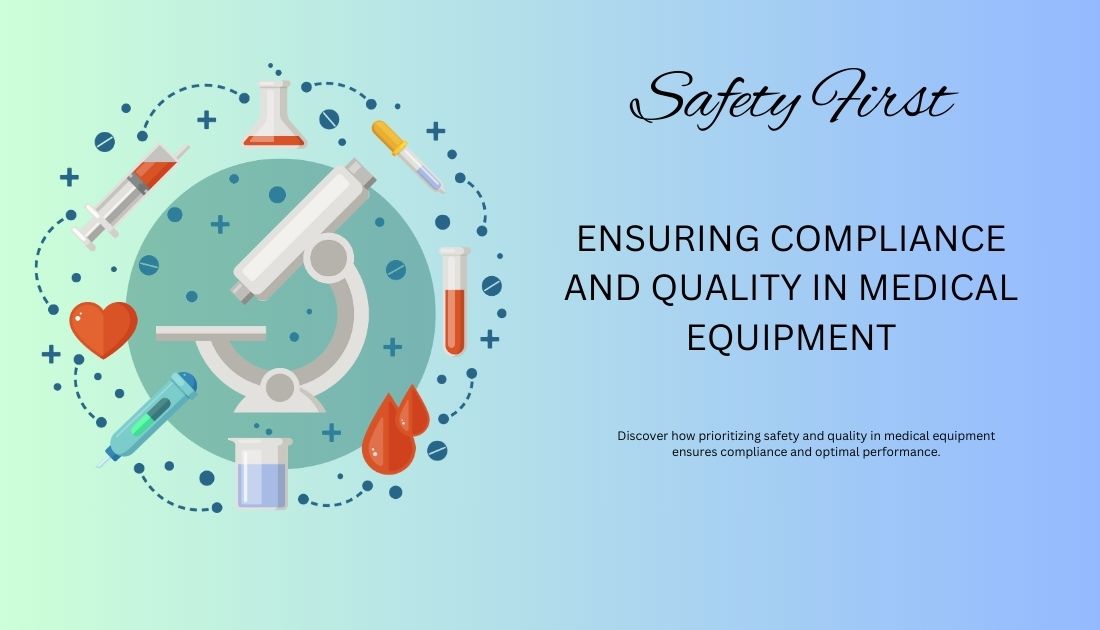Safety First: Ensuring Compliance and Quality in Medical Equipment

In healthcare today, it’s crucial that medical equipment is safe and does its job properly. This is because it directly impacts how well patients receive treatment and how good our healthcare systems are overall. This article will explore how we ensure that medical equipment meets safety standards and remains high-quality. We’ll discuss the rules it must follow, how we test it, ways we handle risks, the training needed to use it, and the challenges posed by new technology.
Introduction to Medical Equipment Safety
Medical equipment includes a wide range of things, such as tools for checking health, devices for treatment, tools used in surgeries, and machines that help people stay alive. Keeping medical equipment safe is all about following the rules and making sure everything is of really good quality. This is super important for keeping patients safe and making sure everyone in healthcare trusts the equipment they use.
Importance of Compliance and Quality
It’s really important to follow the rules from organizations like the FDA in the US, CE marking in Europe, and ISO certifications globally to ensure that medical equipment is safe and functions properly. These rules cover everything from designing and making the equipment to testing and checking it after it’s being used. This ensures that medical devices are trustworthy and do their job well.
Regulatory Standards for Medical Equipment
The FDA has rules for medical devices based on how much risk they have, ranging from low risk (Class I) to high risk (Class III). Manufacturers must follow these rules, like getting approval for their devices and following quality standards, to be allowed by the FDA. The CE marking shows that devices meet safety rules in the EU, and ISO standards like ISO 13485 help keep quality the same across the world for medical devices.
Testing and Validation Processes
Testing medical equipment thoroughly is very important to ensure it works safely and effectively. Different tests, like checking its design and trying it in various situations, help make sure it does what it’s supposed to do. Studies with real patients also show how well and safely the equipment works, which helps create rules on how to use it. Testing also checks how easy it is for people to use the equipment correctly so they don’t make mistakes while using it.
Risk Management in Medical Equipment
It’s really important to manage risks well with medical equipment. This involves finding, examining, and lessening any potential dangers that might come with using the equipment. Manufacturers use tools like Failure Mode and Effects Analysis (FMEA) to analyze risks and plan how to reduce them in an organized way. After the equipment is in use, keeping track of how it’s performing and any issues that arise and listening to user feedback helps make it even safer as time goes on.
Importance of Training and Education
Training and learning are really important for everyone who uses medical equipment. Healthcare workers need to know how to use the equipment correctly, keep it working well, and handle emergencies to give patients the best care possible. Doctors, nurses, and technicians learn best through hands-on training and helpful resources that teach them how to avoid mistakes. Patients also benefit from learning about how the equipment works, how to use it safely, and how to take better care of themselves, which helps them stay involved in their treatment.
Emerging Technologies and Safety Challenges
New technologies like smart devices and AI bring great opportunities and safety worries to medical equipment. Smart devices can monitor data in real-time, perform check-ups from afar, and predict when maintenance is needed, making healthcare better for patients. However, with more connections, we also need strong security to protect patient information and keep devices safe from hacking.
Case Studies and Success Stories
Examining real-life examples helps us learn what works best. We see how medical equipment follows rules and maintains quality. Following rules improves quality. Managing risks smartly is important. Collaboration leads to better outcomes. Stories of companies doing this well inspire others to do the same and become leaders in innovation.
Conclusion:
It’s crucial to follow rules, ensure top-notch quality, prepare for risks, and train well to keep medical equipment safe. Using new technology wisely can also contribute to improving medical equipment over time. When we prioritize patient safety and think of innovative solutions, it leads to collaboration among everyone in healthcare. Striving for the highest quality is essential to make things better for patients everywhere.